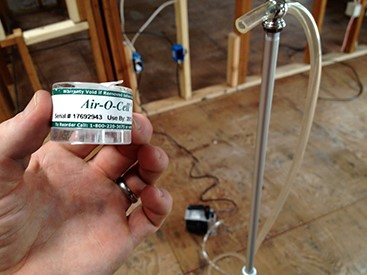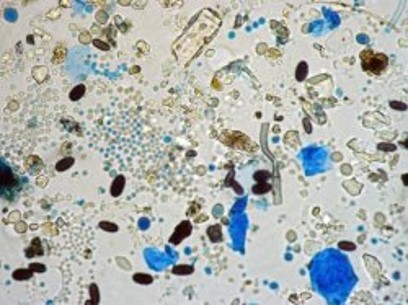by Michael A. Pinto, CSP, SMS, CMP, CFO — Wonder Makers Environmental
Failing Post-Remediation Air Sample Results Due to Low Levels of “Target” Spores
At the January 2019 Indoor Air Quality Association (IAQA) meeting in Atlanta, a general session with all the attendees involved a panel discussion with experts discussing the Best Practices for Mold Post-Remediation Verification (PRV) Air Sampling. Part of that debate involved the discussion of whether a single spore of certain fungal types which show up in the analysis of post-remediation air samples should be enough to classify the remediation effort as a failure. The author had the distinct honor of offering the arguments in favor of that position. Those arguments are summarized here which are in favor of having a strict criterion for evaluating analytical data from post-remediation samples.
Understanding the Parameters of the Discussion
There are plenty of discussions in the industry about the accuracy and usefulness of spore trap air samples for different aspects of the mold remediation industry. However, there is no doubt that currently those types of samples are most commonly used when evaluating the effectiveness of mold remediation projects. As such, the points in this article are focused on the fact that it has already been decided to use spore trap air samples as part of the process of determining the effectiveness of the remediation.
Another important factor to consider (when arguing that small quantities of certain spores should result in additional remediation and/or re-sampling), is that the specific endpoint related to the interpretation of the air sample results is clearly set out for all involved parties at the beginning of the project. Clearly communicating the expectations that the contractor is going to meet is the biggest hurdle to acceptance of low levels of certain types of spores resulting in a failure for the project. It is only fair to the building owner and the remediation contractor that the consultant lay out in writing the specific parameters which will be used to judge the overall effectiveness of the work prior to the start of the project.
The appropriateness of using spore trap air samples, and having very strict criteria for the interpretation of the analytical results, must also be viewed within the “big picture” of the standard of care for assessing project effectiveness. Regardless of what sort of sampling is conducted, those results need to be evaluated in conjunction with the information obtained from a detailed visual inspection of the work area. Indeed, if the work area cannot pass such an inspection that confirms the surfaces are dust-free, then no sampling should even be attempted.

Collecting a post-remediation spore trap air sample – Photo by IAQ Technologies, Inc.
Given that the work area passes a comprehensive visual inspection and spore trap air samples are collected appropriately (commercially available cassettes, proper flow rate, appropriate runtime, correct placement to represent the work area, etc.), sampling data can be critical to determining if the remediation work was conducted properly. Even so, the interpretation of the analytical data needs to be framed by the common sense understanding that the world is not spore-free. Therefore, some residual spores after remediation are to be expected. However, the argument is that certain types of spores are not acceptable; even at extremely low concentrations.
What Are the Spore Types of Concern?
Many types of mold are considered to be part of a “normal fungal ecology” inside the building. While the specific mix of spores in a building will vary by location, season, time of day, and amount of infiltration of outside air, there are certain fungal types typically not found in buildings unless they are water-damaged. At Wonder Makers, we use the term “Target Spores” to reflect the five types of mold that are unacceptable in terms of post-remediation air sample results: Stachybotrys, Chaetomium, Memnoniella, Fusarium, and Trichoderma.
This list was not developed randomly, but reflects a number of specific characteristics shared by these target spores. First and foremost, the identification of these types of spores inside buildings correlates closely with the structure being water-damaged. None of these five target types are common in indoor air samples in well-maintained, clean buildings. Indeed, these target spore types are rarely seen in outdoor air samples. This is because airborne distribution of the spores for reproductive purposes is a secondary method for such fungal organisms as compared to distribution by flowing water, foot traffic, etc.
Another reason that certain types of mold have been designated as target spores is because there is ongoing discussion regarding the fact that certain molds may produce more significant health effects upon exposure than others. Both medical data and public perception about certain mold types being “worse” than others is now frequently tied to the fact that the list of target spores typically produce more dangerous mycotoxins than other types of fungal organisms.
Post-Remediation Is Designed to Gauge the Effectiveness of the Work
When using a strict criterion for review of analytical data, it is important to remember the overall purpose of the remediation effort. For the area of structure under the contractor’s control, the ultimate goal is to return the building to a pre-loss condition. Given the previous discussion that target spore types are not typically found in air samples in buildings with a normal fungal ecology, allowing “small” concentrations in post-remediation air samples to be acceptable is not logical.
The argument that contractors should get a “pass” on a small number of target spores also tends to diminish the capabilities of the contractors working in the mold remediation industry. Equipment and techniques which improve the efficiency and effectiveness of the work are being added to the mold remediation field every day. Proper use of these supplies and work practices means that the surfaces and air in mold remediation containments can be thoroughly cleaned.
Honest Reporting
One of the significant concerns which arise when discussing low levels of target spores recovered from post-remediation air samples is how often professionals in the mold remediation field will change their terminology without justification. Laboratory results for spore trap air samples contain both raw counts and extrapolated levels. The raw counts represent what was identified under the microscope. However, those are converted to counts per cubic meter of air (c/m3) because the analytical process uses a mathematical formula to determine the concentration of spores in the air.
Since airborne concentration is the subject being evaluated, most of the discussion regarding post-remediation results centers around the values represented in counts per cubic meter of air. Oddly enough, when individuals point to the low levels of target spores that they are trying to ignore or downplay in a post-remediation sample, they will often switch to the raw counts to make it sound less significant. This duplicity in terminology undermines the scientific process being utilized to come up with the spore concentrations.
How Much Is Too Much?
The biggest difficulty in taking a position regarding certain levels of target spores which are acceptable following a remediation activity is determining what actual, and numerical levels are appropriate to have in a home or commercial building. If 24 counts per cubic meter of air of Stachybotrys is acceptable (which may equate with one spore on the raw count), then what about 48 c/m3? And, if 48 c/m3 is okay, then what about 96 c/m3? Where does it end and what is it based on given that such spores are rarely seen in buildings that are not water-damaged?

Airborne debris and mold spores at 400x brightfield microscopy
Individuals who advocate that low levels of target spores are acceptable for post-remediation needs to contemplate the client difficulties when professionals in the mold remediation field are telling the homeowners it is suitable to leave “toxic” spores behind. How does such a position reduce the long-term liability of the contractor or consultant when there currently is no validated medical evidence which indicates an acceptable threshold for such exposures?
Zero Tolerance of Target Spores Is Achievable and Reasonable
As an advocate of zero tolerance of target spores in post-remediation spore trap samples, I have had hundreds of discussions over the years regarding this issue. Oftentimes, what comes out of those discussions is that contractors and consultants are afraid to make a commitment to such a “stringent” standard for fear that it will result in multiple failures/callbacks. In reality, having work areas free of target spores is a very practical goal that is being reached every day.
It is true that contractors who are not used to such a stringent criterion face a learning curve in how to complete their projects. However, when clear communication of the endpoint is offered at the beginning of the project (along with reminders of proper work procedures), the criteria of no target spores is easily met. At that point, the ease in addressing client concerns and reduced liability for everyone involved replaces any initial fear of being held accountable to a zero tolerance. That is why no stinking Stachy is allowed on my projects!
About the Author
Michael Pinto is the CEO of Wonder Makers Environmental; a multi-faceted organization that assists individuals dealing with indoor environmental concerns. Wonder Makers specializes in resolving problems related to asbestos, lead, mold, micro-organisms, chemicals, and mysterious IAQ situations. Michael has earned a number of professional titles beyond his doctoral level education in environmental engineering including Certified Safety Professional, Safety Management Specialist, Certified Mold Professional, and Certified Forensic Operator. He has authored 6 books and more than 220 published articles. During his 39 years in the industry Michael has supported the industry by volunteering and developing guidance documents with EIA, ECA, NSC, ASTM, IICRC, RIA, CIRI, BioPTO, and others. He can be reached at 888-382-4154, or at info@wondermakers.com.
The post Why a Single Spore Matters appeared first on Healthy Indoors.





















